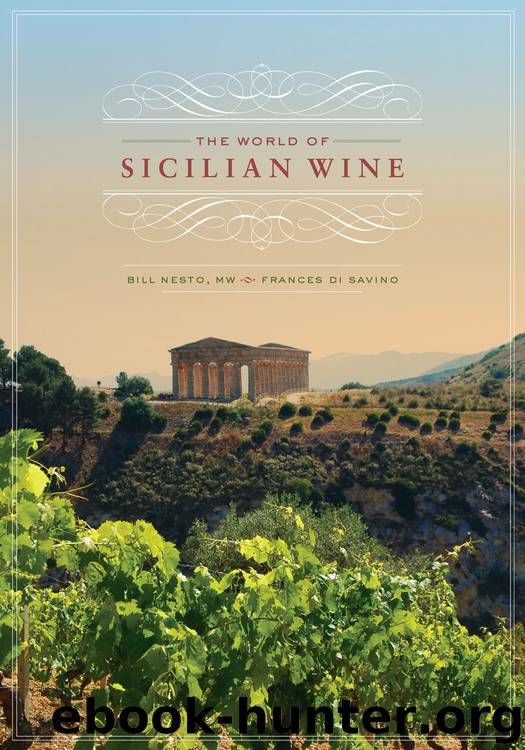World of Sicilian Wine by Nesto Bill MW

Author:Nesto, Bill, MW
Language: eng
Format: epub
ISBN: 9780520266186
Publisher: University of California Press
Other recommended producers and their wines:
Cantine Rallo Passito di Pantelleria
Carole Bouquet Sangue d'Oro Passito di Pantelleria
Case di Pietra Niká Passito di Pantelleria
D'Ancona e Figli Cimillýa Passito di Pantelleria
Miceli Entellechia Passito di Pantelleria
Miceli Yanir Passito di Pantelleria
Serragghia di Giotto Bini Moscato di Pantelleria
Solidea Passito di Pantelleria
MARSALA
A century troubled by two world wars and one Great Depression did little to support Marsala, a product that depends on international trade and economic stability. After World War II, Marsala producers increasingly combined their wine with the flavors of nuts, fruits, spices, and eggs to attract more customers with different tastes. Food industries and consumers purchased these “Marsala"s for culinary preparations and for the enhancement and preservation of various foods. The popularity of the so-called Marsala Speciali caused the image of Marsala to transition from sophisticated beverage to commodity product indirectly consumed as an ingredient. The most challenging problem that Marsala—like Sherry and Madeira, its two prototypes—has faced has been the shift in consumer tastes from oxidized fortified wines to fruity table wines.
The market deterioration has been dramatic. As of 1921 there were about fifty enological companies in Marsala. After World War II there was a proliferation of Marsala companies, mostly small, that capitalized on commercializing the wine and priced it so as to undercut the established Marsala houses. By 1950 there were 226 such operations. By 1970 about a hundred Marsala producers remained. There were only fifteen in 2010, when a bottle of Fine Marsala could be purchased for as little as one and a half euro. The final slap was the “Is Marsala a bluff?” debate that took place on a Sicilian wine blog, “Cronache di Gusto,” from April to June 2010. Will Marsala survive?
Though John Woodhouse modeled Marsala after Madeira, Benjamin Ingham moved its style more toward that of Sherry. He incorporated Sherry techniques such as maturation by solera, a system that homogenizes wine quality and style by systematically blending younger with older wine. As with Sherry, in Marsala production, grape spirit is added to a fully fermented dry white wine. Though red grapes were used to make ruby Marsalas during the nineteenth century, and though the 1984 revision of the Marsala production disciplinary reinstated a ruby version, rubino, made mostly with red grapes, Marsala is largely a fortified white wine. Before the mid-nineteenth century the triad of Catarratto, Inzolia, and Grillo dominated Sicilian vineyards. Inzolia proved to be too vulnerable to powdery mildew, which attacked in the mid-nineteenth century. Grillo largely took its place until the end of the nineteenth century. Grown in alberello, Grillo grapes are harvested when their sugar is high and can be naturally vinified into 14 to 17 percent alcohol wines. From 1900 to 1920, when phylloxera necessitated the replanting of vineyards, farmers opted to plant the higher-yielding Catarratto instead of Grillo. Catarratto produces lower-alcohol wines than Grillo. Rectified concentrated grape juice can be added to Catarratto musts to increase the base wine alcohol degree. More grape spirit can to be added to fortify the wine. Purists
Download
This site does not store any files on its server. We only index and link to content provided by other sites. Please contact the content providers to delete copyright contents if any and email us, we'll remove relevant links or contents immediately.
| Buying Guides | Cellars |
| Champagne | Collecting |
| Spirits | Whiskey |
| Wine | Wine Pairing |
| Wine Tasting |
Whiskies (Collins Gem) by dominic roskrow(42214)
101 Whiskies to Try Before You Die by Ian Buxton(42182)
Whiskies Galore by Ian Buxton(40332)
Craft Beer for the Homebrewer by Michael Agnew(17446)
Right Here, Right Now by Georgia Beers(3497)
Not a Diet Book by James Smith(2726)
Water by Ian Miller(2584)
The Coffee Dictionary by Maxwell Colonna-Dashwood(2531)
Kitchen confidential by Anthony Bourdain(2306)
Coffee for One by KJ Fallon(2007)
Smuggler's Cove: Exotic Cocktails, Rum, and the Cult of Tiki by Martin Cate & Rebecca Cate(1979)
Beer is proof God loves us by Charles W. Bamforth(1920)
Superfood Smoothie Bowls: Delicious, Satisfying, Protein-Packed Blends that Boost Energy and Burn Fat by Chace Daniella(1903)
Talking as Fast as I Can by Lauren Graham(1832)
Bourbon: A Savor the South Cookbook by Kathleen Purvis(1791)
A Short History of Drunkenness by Forsyth Mark(1720)
Eat With Intention by Cassandra Bodzak(1688)
Cocktails for the Holidays by Editors of Imbibe magazine(1626)
Colombia Travel Guide by Lonely Planet(1609)
